- Submissions

Full Text
Aspects in Mining & Mineral Science
The First Finding of Water-Free Copper Iodide and Iodate in a Chrysoberyl-Sillimanite Association from the Roncadeira Pegmatite, Borborema Province, NE-Brazil
Thomas Rainer1*, Beurlen Hartmut2 and Davidson Paul3
1Im Waldwinkel 8, D-14662 Friesack, Germany
2Department of Geology, Federal University of Pernambuco, Recife, Brazil
3Centre for Ore Deposits and Earth Sciences, University of Tasmania, Hobart 7001, Australia
*Corresponding author:Thomas Rainer, Im Waldwinkel 8, D-14662 Friesack, Germany
Submission: June 20, 2023: Published: July 03, 2023

ISSN 2578-0255Volume11 Issue4
Abstract
We found water-free copper iodide and iodate in a chrysoberyl-sillimanite association from the Roncadeira pegmatite, Borborema Province, NE-Brazil, during microscopic and Raman spectroscopic studies. The salesite-like mineral forms in this chrysoberyl-bearing sample copper sulfate blue crystals in a fine-grained chrysoberyl, albite, quartz, and sillimanite matrix. We used Raman spectroscopy to identify the salesite-like mineral and have the obtained data compared with the salesite from Chuquicamata, Chile.
Keywords:Raman spectroscopy; Copper iodide; Copper iodate; Chrysoberyl-sillimanite association; Pegmatite
Introduction
During the Raman investigation of the chrysoberyl-sillimanite association [1], we found some tiny blue crystals showing a very strong Raman band at about 770cm-1. This mineral shows moderate solubility in water and is unstable under Raman excitation. According to the RRUFF database, this blue mineral looks like salesite [Cu(IO3)(OH)], a rare iodate mineral described primarily from Chuquicamata, Chile [2]. However, we could not determine any water, meaning the mineral is not salesite. Using Raman spectroscopy, we found a very strong complex Raman band for these salesite-like minerals, which is typical and dominant for all studied iodate grains in the sample. We found 79, 110, 140.6 and 164cm-1 as the main components specific for marshite [CuI].
Sample Description
A concise description of the sample material is given in Beulen et al. [1]. The hand specimen (Figure 1) shows the chrysoberyl-bearing aplite (quartz, albite, muscovite) rock. Up to now, the quartz’s red color was interpreted as the impregnation of iron hydroxide. However, according to the present study, the origin of the red color of quartz is caused by fine-disperse distributed copper iodide. There are also tiny crystals of red copper iodide (Figure 2). The yellow-coloring quartz is also caused by copper iodide. The salesite-like mineral forms in this chrysoberyl sample copper sulfate blue crystals in a fine-grained chrysoberyl, albite, quartz, and sillimanite matrix. The most prominent grain has a dimension of 250x100μm, and smaller blue crystals are about 60x50μm (Figure 3). Besides the blue crystals, there are also more petite black and brown crystals around the larger blue ones with the very characteristic intense Raman band around 770cm-1. The large blue crystal shows a yellow-brown rim. Near the largest blue crystal, there are also a couple of very dark red-brown aggregates of marshite [CuI].
Figure 1:Hand specimen of the copper iodide and iodate-bearing (red-colored quartz) chrysoberyl assemblage. Black arrows mark some pale yellowish-green chrysoberyl crystals.
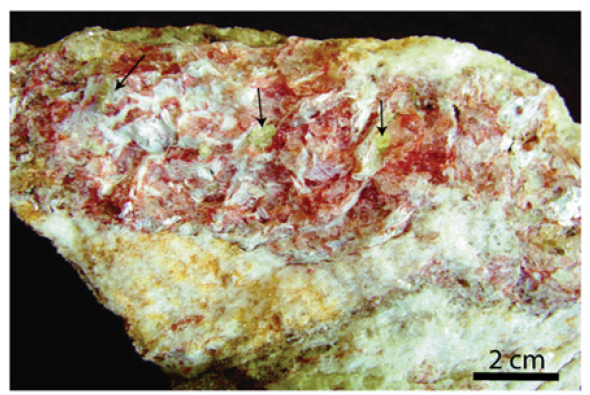
Figure 2:Marshite [CuI] aggregate in sillimanite-bearing quartz from the Roncadeira pegmatite. The grey needles in quartz are sillimanite crystals.
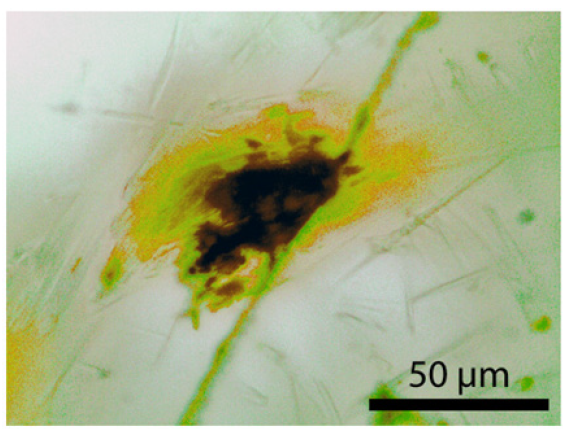
Figure 3:Copper sulfate blue salesite-like crystals in a fine-grained chrysoberyl, albite, quartz, and sillimanite matrix.

Raman Spectroscopy
Raman spectra were recorded with the EnSpectr Raman microscope RamMics M532 in the spectral range of 0-4000cm-1 using a 50mW single mode 532nm laser, an entrance aperture of 20μm, a holographic grating of 1800g/mm, and a spectral resolution of 4-6cm-1. Depending on the grain size, we used microscope objectives with magnifications between 3.2x and 100x. The position of the Raman bands was controlled before and at the end of each series of measurements of the Si-band using a single crystal chip of semiconductor-grade silicon. The run-to-run repeatability of the line position (from 20 measurements each) was ±0.3cm-1 for Si(520.4±0.3cm-1) and 0.5cm-1 for diamond (1332.3±0.5cm-1 over the range 80–2000cm-1), respectively. As a diamond reference, we used a water-clear natural diamond crystal. For the identification of the mineral phases using Raman micro-spectroscopy, we used the RRUFF database and the Crystal Sleuth program [3].
Result
fingerprint region at about 772cm-1 and a few weaker, untypical bands (Figure 4). Only the sharp and relatively strong Raman band at 200.4±0.8cm-1 (lattice mode) is an exception. According to During et al. [4], the strong line at 772cm-1 corresponds to the 754cm-1 line of NaIO3 and can be assigned to IO2 symmetric stretching because the symmetric stretching will be the more intense Raman line [4]. We often found in the blue crystals from Roncadeira characteristic Raman bands of carbonaceous material with the typical strong bands at 1351±6 cm-1 and 1876±6cm-1 (n=10). That speaks for reduced conditions during the copper iodate crystallization. Table 1 summarizes the Raman spectroscopic studies on the copper iodate sample from the Roncadeira pegmatite. Typical for all iodides in the sample is the very intense, broad asymmetric, and complex band between 50 and 250cm-1 (Figure 5).
Figure 4:Raman spectrum of the salesite-like copper iodate in a chrysoberyl-sillimanite association from the Roncadeira pegmatite, Borborema Province, NE-Brazil. Note the intense and complex asymmetric Raman below 400cm-1, generated by different strong copper iodide bands merged.
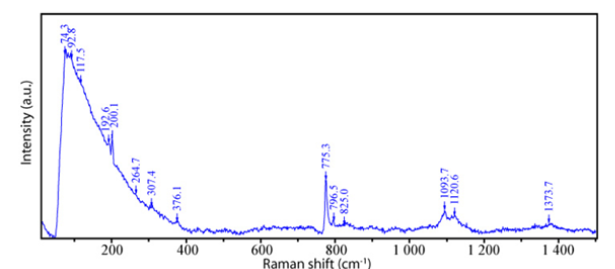
Table 1:Results of the Raman spectroscopic studies on the copper iodide and iodate sample from the Roncadeira pegmatite in comparison to the salesite from the Chuquicamata deposit in Chile. Data with a standard deviation is the result from 20 measurements. m-medium, s-strong, vs-very strong, w-weak, vw-very weak.
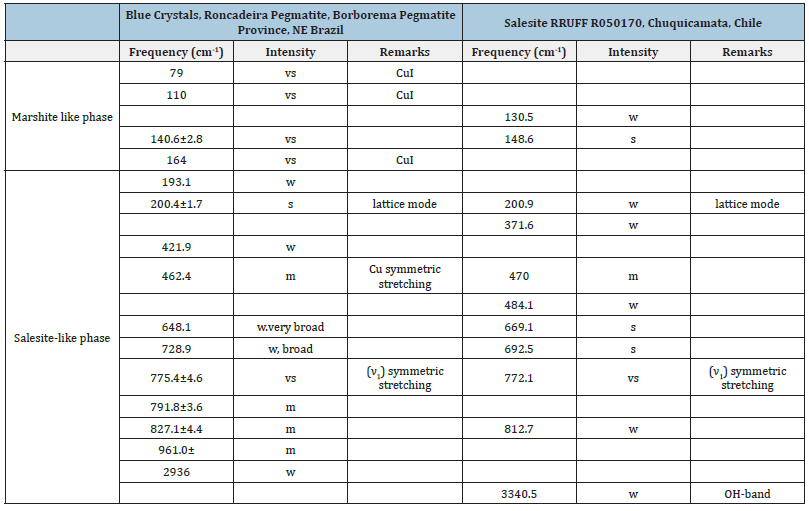
Figure 5:Raman spectra of pure quartz (lower spectrum) compared to quartz with increasing copper iodide concentration. The main line for CuI is about 141cm-1 (measured: 140.6±2.8cm-1). Note the bulk intensity increases strongly with the CuI concentration.
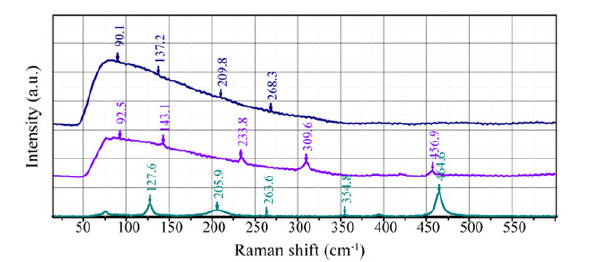
Opposite to salesite from the Chuquicamata deposit in Chile, the blue crystals from the Roncadeira pegmatite show in the lowfrequency region of the Raman spectrum a broad, asymmetric, and very strong Raman band which is maybe a combination of different species which are merged. Only the band at about 200cm-1 is often very sharp and intense. The broad asymmetric complex band between 80 and 200cm-1 results from marshite-like [CuI] - copper iodide components in the copper iodate-bearing sample, mostly yellow-brown rims around the blue crystals, and dispersed in redcolored quartz. Often is also a band at 464cm-1 present, which can be attributed to the symmetric stretching of CuO. Quartz which is with such a band is not in the vicinity.
Discussion
The salesite-like crystals and the copper iodide in the Roncadeira pegmatite are the first iodate and iodide minerals described in a high-temperature pegmatite association. However, the differences in the Raman data of both minerals are too significant to classify both minerals as salesite. The differences in the Raman spectra of both iodate minerals can be traced back to the different association and maybe by a larger concentration of BrO3 - indicated by the three lines at 786, 796, and 829cm-1 [5], as well as by a significantly higher content of copper iodide, which forms small separate crystal around the blue colored iodate mineral or is fine-disperse distributed in quartz. Furthermore, the salesite from Chuquicamata, Chile, contains about 3.7% water [6-9]. The salesite-like mineral from the Roncadeira pegmatite is water-free. The difference results probably from the different mineralization settings: pegmatite versus oxidized zone of a copper porphyry deposit. Because the red-colored quartz from the Roncadeira pegmatite was discussed as hematite, it would be nice to check the distribution and regional frequency. Is there an iod- and/or copper deposit? Which meaning has the iod-complexed copper for coloring the famous “Paraíba tourmaline”? This copper bearing tourmaline is a “electric blue” elbaite, which is one of the most highly prized gemstones and is worth up to $25,000 per carat [7].
References
- Beurlen H, Thomas R, Melgarejo JC, Da Silva JMR, Rhede D, et al. (2013) Chrysoberyl-sillimanite association from the Roncadeira pegmatite, Borborema Province, Brazil: implication for gemstone exploration. Journal of Geosciences 58: 79-90.
- Palache C, Jarrell OW (1939) Salesite, a new mineral from Chuquicamata, Chile. American Mineralogist 24(6): 388-392.
- Lafuente B, Downs RT, Yang H, Stone N (2015) The power of database: the RRUFF project. In: Armbruster T, Danisi RM (Eds.), Highlights in mineralogical crystallography. De Gruyter, Berlin, Germany, pp. 1-30.
- During JR, Bonner OD, Breazeale WH (1965) Raman studies of iodic acid and sodium iodate. The Journal of Physical Chemistry 69(11): 3886-3892.
- Berenblut BJ, Dawson P, Morse P, Wilkinson GR (1973) The vibrational spectrum of sodium bromate. Journal of Raman Spectroscopy 1: 523-532.
- Anthony JW, Bideaux RA, Bladh KW, Nichols MC (2003) Handbook of Mineralogy. Volume V Borates, Carbonates, Sulfates. Mineral Data Publishing Tucson, Arizona, US, p. 813.
- Simmons WB, Prezzotta F, Shigby JE, Beurlen H (2013) Granitic pegmatites as sources of colored gemstones. Elements 8(4): 281-287.
- Berman H, Wolfe CW (1940) Bellingerite, a new mineral from Chuquicamata, Chile. American Mineralogist 25(8): 505-512.
- Ghose S, Wan C (1978) Salesite, CuIO3(OH), and Cu(IO3)22H2O: A comparison of the crystal structures and their magnetic behavior. American Mineralogist 63: 172-179.
© 2023 Thomas Rainer. This is an open access article distributed under the terms of the Creative Commons Attribution License , which permits unrestricted use, distribution, and build upon your work non-commercially.
 a Creative Commons Attribution 4.0 International License. Based on a work at www.crimsonpublishers.com.
Best viewed in
a Creative Commons Attribution 4.0 International License. Based on a work at www.crimsonpublishers.com.
Best viewed in 







.jpg)






























 Editorial Board Registrations
Editorial Board Registrations Submit your Article
Submit your Article Refer a Friend
Refer a Friend Advertise With Us
Advertise With Us
.jpg)






.jpg)














.bmp)
.jpg)
.png)
.jpg)










.jpg)






.png)

.png)



.png)






